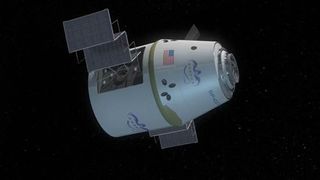SpaceX's Commercial Spaceship Chasing Space Station in Orbit

The first commercial spacecraft ever launched toward the International Space Station is playing a game of catch-up today (May 23) as it heads toward an unprecedented rendezvous with the orbiting lab.
Dragon, built by commercial rocket firm Space Exploration Technologies Corp. (SpaceX), launched atop a Falcon 9 rocket from Cape Canaveral Air Force Station in Florida early Tuesday (May 22). The unmanned capsule will become the first non-governmental vehicle to meet up with the space station and attach to it at 240 miles (390 km) above Earth.
The spacecraft is packed with about 1,200 pounds ( 544 kilograms) of supplies for the space station, including food, clothing and student scientific experiments.
The launch went off flawlessly, after an earlier attempt on May 19 was called off less than a second before liftoff because of a rocket engine glitch. [Launch Photos for SpaceX's Dragon Capsule]
"We obviously still have to go through a number of steps but everything is looking really good and I would really count today as a success no matter what happens with the rest of the mission," SpaceX founder and chief engineer Elon Musk said after the launch.
On Thursday (May 24), the Dragon spacecraft will approach the station, flying 1.5 miles (2.5 kilometers) away from it in a maneuver designed to test its navigation and control systems. If all goes smoothly, the capsule will repeat the fly-by Friday (May 25) and eventually move close enough for astronauts Don Pettit and Andre Kuipers, inside the lab, to grab onto Dragon with the space station's robotic arm.
Pettit will use the arm to position Dragon on the end of the outpost's Harmony node, where it will be berthed for about a week. The hatches between the station and the space capsule are due to be opened on Saturday (May 26).
Get the Space.com Newsletter
Breaking space news, the latest updates on rocket launches, skywatching events and more!

NASA has been working to hand off transportation duties to low-Earth orbit to the commercial space sector so the agency can build a new vehicle to take people to asteroids, the moon and Mars.
"This frees us up to really focus on beyond low-Earth orbit," said William Gerstenmaier, associate administrator for NASA's Human Exploration Operations Directorate. "We're looking for those bigger targets to push beyond. This lets NASA focus on those harder destinations."
You can follow SPACE.com assistant managing editor Clara Moskowitz on Twitter @ClaraMoskowitz. Follow SPACE.com for the latest in space science and exploration news on Twitter @Spacedotcom and on Facebook.
Join our Space Forums to keep talking space on the latest missions, night sky and more! And if you have a news tip, correction or comment, let us know at: community@space.com.

Clara Moskowitz is a science and space writer who joined the Space.com team in 2008 and served as Assistant Managing Editor from 2011 to 2013. Clara has a bachelor's degree in astronomy and physics from Wesleyan University, and a graduate certificate in science writing from the University of California, Santa Cruz. She covers everything from astronomy to human spaceflight and once aced a NASTAR suborbital spaceflight training program for space missions. Clara is currently Associate Editor of Scientific American. To see her latest project is, follow Clara on Twitter.
